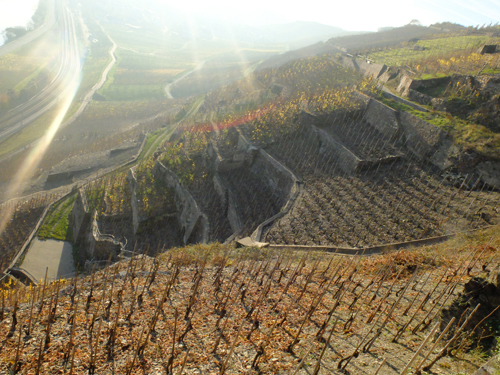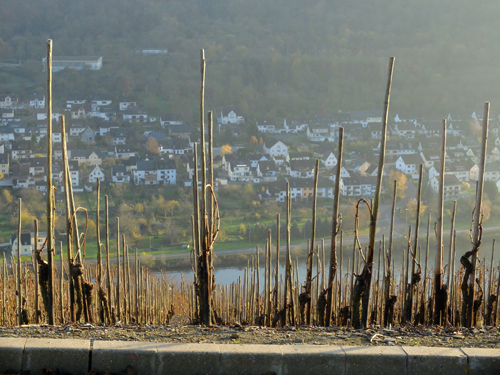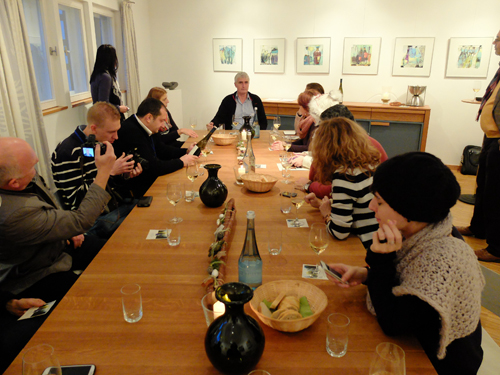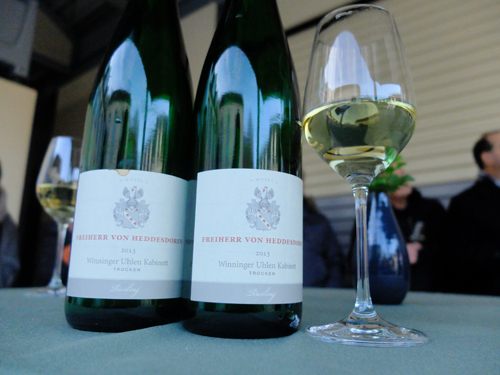
By Malkhaz Kharbedia
Wine Diaries – Germany, Letter #1
During the second half of November, a study tour of over ten participants has been held under the program of Private Sector Development in the South Caucasus implemented by the German Society for International Cooperation, LTD. The training tour incorporated different visits to a number of wine producing regions of Germany as well as various business and enogastronomic meetings.
The study tour was focused on two main areas – wine and tourism. As part of the program, we met different leaders and representatives of various German institutions including state, non-government and private organizations where we had really productive meetings. In addition to this, we visited about ten wine cellars and tasted dozens of wines that were made following various winemaking methods and techniques. Every evening we would have unforgettable celebrations of food and wine pairing that were hosted and organized by Martin Darting, a wine expert and enthusiast, and enjoy the fun dinners that offered extraordinary pairing of wine and German gastronomy.
My diary is a written record of these days, events, the issues that have been discussed, and of course, of food and wine experience. In a nutshell, it deals with everything that has brought together knowledge and hedonism, education and the pursuit of pleasure.

We happened to be pretty exhausted even on the second day of our visit because of a long flight and the busy schedule of the first day there. None of our group members seemed rested, still, no one complained as we had a trip to Mosel ahead of us. We left Deidesheim and headed to Koblenz around 10 a. m., which was an hour or an hour and a half late compared to our schedule. We couldn’t help taking notice of a variety of landscapes, fileds, hills, gorges, and most importantly, an abundance of vineyards in the course of our journey. After passing the vineyards of the Pfalz region, we were exposed to the vineyards of Rheinhessen on the right side, then Nahe wine region on the left side followed by the Rheingau wine region on the right side again. After going through a pass in a small and foggy mountain range, we reached the confluence of the Mosel and the Rhine rivers, where the city of Koblenz was situated. Finally, we arrived at one of the locally established gastronomical education centers as late guests, where we had been expected for quite a while.

Our hosts have been Ms. Sabina Dias, the Head of the Chamber of Commerce and Industry, Mr. Johannes Steinmetz, Director at the German Wine and Sommelier School, and Mr. Bernand Meiser, an examination committee member. This organization is endorsed by the Chamber of Commerce and Industry (IHK). The membership in the chamber is mandatory under national laws for all industrial businesses and companies. The membership in not required for handicraft trade, farmers and self-employed professionals. IHK itself serves the interests of its members at administrative, political and public levels.
IHK makes its mark with regard to the high quality vocational training opportunities for its members, through their definitions of standard examination criteria and procedures as well as the development of educational concepts.
The Gastronomical Education Center (GBZ) that we visited offers different services in the field of vocational education and training. The services range from extended occupational training courses to continuing education programs for wine-related topics.
In addition to delivering a discourse on various interesting topics regarding wine and sommelier education, Mr. Johannes Steinmetz, the Director at the German Wine and Sommelier School (Deutsche Wein - und Sommelierschule), also discussed some of the existing issues. Mr. Meiser, who was in charge of vocational training direction, talked about the importance of dual education, its principles and other important topics.
This meeting once again showed an exceptional dedication of Dariko Gogoli, who was our shepherd and the de facto leader of the delegation. We started to enjoy her wonderful, cheerful translations right from the start in Neustadt while she was engaging each of us in the conversations in order to allow us to give specific explanations about different subjects. So it was a really fun and impressive experience for all of us.
After being served with a lamb steak and salad for dinner, it was time to head to the Mosel vineyards, to which we all had been looking forward. It was also time to end my two-day complaining about being able to observe vineyards only from the bus windows. It took us several minutes from Koblenz to get to the Moselle River gorge and that’s where it all started! We began to notice very steep, vine-covered slopes with small plot sizes. It looked like a sloping heaven. Our destination was Vinningen, one of the best wine villages of Mosel, where we could take a close look at the vineyards, visit wine cellars and taste some local wines.
From north to south-west, in the direction opposite to the Mosselle River flow, Vinningen is the first village, which is famous for its steep vine slopes and distinguished, excellent white wines. One of the buildings in the center of the village is embellished with a wall-painting and a Latin saying: “Vinum Moselanum omni tempore sanum” roughly meaning: “Mosel wine – always a healthy one.”
A mobile wine bar attached to a tractor and composed of a long table and benches, with a box of wine in it, was waiting for us in the center of the village (or call it a small town). There were large and small holes in the bar table that served as holders for wine bottles and glasses. As soon as we departed, we opened the wine bottles, poured them in our glasses and offered the first toast. We were quite tipsy once we reached the final and the highest point of the vine terraces, where we stopped shortly to enjoy the beautiful views and the charm of the steep vine slopes. We tasted Frie Winery dry (Trocken) and off dry (Feinherb) Rieslings as well as simple and delicious wines, which tasted even better in the course of our wonderful journey.
After several turns, we found ourselves at the top of the vine terraces that overlooked the picturesque views of the river and the vineyards – the river bank and the railway side by side, boats sailing on the river, and in the opposite direction, to the west, the umbrageous slopes, all covered with woods. Apparently, because of the lack of the direct sunshine, no one would ever consider planting vineyards there. Vinningen vine slopes produce exceptional crops, most of which are Riesling grapes. The yield is quite low and as a result, the quality – quite high. The grapes cannot be harvested mechanically, which makes these vines very labor intensive.
There was a tableland above the vineyards and as strange as it may sound, it served as an airfield for small airplanes. We had lots of fun during the trip, went around the circle and in about an hour, visited our first wine cellar.

Freiherr von Heddesdorff is the oldest winery in Vinningen, which has been family-owned since 1424. They have only 10 ha of vineyards, 4 of which are famous terroirs such as Uhlen da Röttgen. The cost of the Riesling produced on this slope is relatively high. Indeed, the wine, when purchased locally, is not pricey at all, the prices ranging from €6 to €15 per bottle. Uhlen Trockenbeerenauslese is the exception, which costs €65 per bottle. This wine is made from the grapes that have been individually picked and are shrivelled with noble rot, often to the point of appearing like a raisin. They are therefore, very sweet and sold in 350-gram bottles.
This winery is engaged in wine tourism. The small beautiful palace incorporates several guest rooms that never lack visitors. It is worth noting that wine tourism developed here in 1990s, as a result of the government support. Because of the tough conditions in the region, it was quite risky to rely only on the winemaking and viticulture. Thus, the government started to offer loans that were favorable to the locals and soon the whole village got involved in the eno-gastronomical tourism, which is working well even during the wintertime.
We tasted many 2013 vintage Riesling wines that were produced from the shale soil terroir of Uhlen. One of them was quite strong example with 13% of alcohol that had green fruit and citrus aromas and cost €8.
Next we visited the most famous wine cellar – Vinothek im Winninger Spital, where the wines, produced by around 20 local winemakers, were represented (including those made by already familiar Fries and Freiherr von Heddesdorff). This three-story wine cellar was owned by a couple – Lothar Krober und Martina Krober. The building was several hundred years old. There was a shop and a cellar next to each other on the first floor. The tasting room was on the second floor. The third floor had a quiet room and there was a very old staircase stem connecting the room down to the first floor. One could assume that this staircase served as the foundation of the house.
This building was once bought by a local commune and according to the suggestion of the local winemakers and growers, an enoteca was established that featured all of the local wines and offered them for tasting and sale. Imagine the same scenario in Artana, Georgia, for example. Having 10-12 small wine cellars and their wines all gathered in a beautiful wine cellar in the center of the village, where everything is transparent, everybody knows the wine prices, not to mention that not only the visitors, but also the local winemakers are given the opportunity to get to know the production of their fellow winemakers.
A tasting panel, which includes visiting specialists as well as local and regional wine experts, chooses the wines for the Vinningen Vinothek on a regular basis. Every wine cellar pays €150 annually for each of their wines (the cellars may offer one or more examples). We couldn’t help noticing one interesting detail here – the fact that vinoteca did not have a kitchen, which was a deliberate decision. As we were told, there already was a restaurant next to the place and they did not want to become their competitor.
Next we visited our familiar Frie wine cellar that had 400 years of tradition. We tasted a variety of wines made by this producer. The cellar offered a wide range of wines and one of the most diverse selections in the village (different styles of white, red and rose wines). There were about 40 wines presented, among which I found the most interesting examples to be Apollo-Terrassen Riesling of 2013 vintage, €10.40, (named after a local and rare Apollo butterfly) and a very delicate Spatburgunder 2012, €15.50, which had been aged for 20 months in oak barrels. Our host, Rainer Fries, led us through the labyrinth of this old wine cellar that was full of old wines, all covered in dust. We even saw a Minotauros statuette there, which was lovingly named “Vinotauros” by the owner.
Another winery we visited was a wine cellar owned by Rudiger Gruber’s. He founded the cellar in 1989 along with his wife. Interestingly, the Rudiger family had been living in Vinningen for 500 years and following winemaking and other agricultural traditions. The father of Mr. Gruber, for example, was not only a farmer, but also oak barrel producer until late 1960s. Actually, all of our hosts noted that they earned their living not just by viticulture and winemaking, but also by growing potatoes or other agricultural products. In addition to this, they had wine tourism, small hotels, restaurants that were often coupled with the wineries. As a result, it was obvious that the growers here did their best to ensure their well-being.
Gruber vineyards occupy 7 ha of land, 95% of which are Riesling grapes. After pressing the grapes, the juice is left in contact with the skins for 6-12 hours, which results in a full-bodied wine of intensive aromas. Interestingly, the best Gruber wines are produced from Uhlen slopes. We also learned from Mr. Rudiger that there are three types of shales found in the Uhlen slopes. Those producers who try to offer a unique, distinctive wines to customers always make sure to specify the type of a shale on a label, from which the Riesling grapes were grown.
Among the wines I tasted there, I was especially impressed by a classic wine, the Kröbers Riesling vom Schiefer, 2013, €6,80. Its grapes were produced from a shale soil. Another wine that I found interesting was Uhlen Laubach of 2011 vintage (€17,50), an excellent wine that had been aged on grape skin sediment for 18 months. As a result, the wine had green-golden color and expressed a mix of delicious aromas of pear, buxus and other herbs.
Indeed, the Trockenbeerenauslese of 2005 vintage, (€60), was particularly exceptional – a 9-year-old wine with the aromas of honey, raisins and dried fruits and with a great potential for aging. In fact, the wine was able to develop, change and become even more sophisticated with time. Obviously, Riesling is one of the best grapes that is capable of aging (especially when it comes to sweet elite Riesling wines). It is also important to mention that it takes a good vintage in order to produce some styles, such as Trockenbeerenauslese or Ice wine in Germany. For example, last time our host made the Trockenbeerenauslese wine was 7 years ago, in 2006, his Beerenauslese was from 2009 vintage and the ice wine from 2008 vintage.
After a very nutritious dinner that incorporated local Mosel dishes and wines, we headed back to Pfalz. We were quite in a hurry as our driver was running out of the driving permit time and was afraid of being fined. This could cause problems not just with a police, but also with a trade union.
© Georgian Wine Club/vinoge.com






